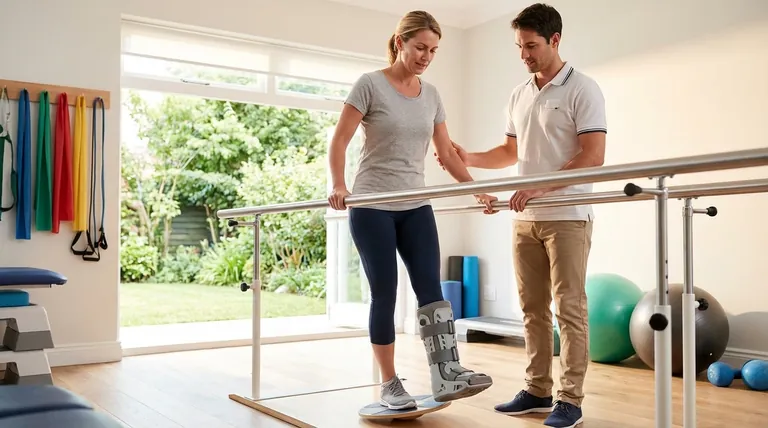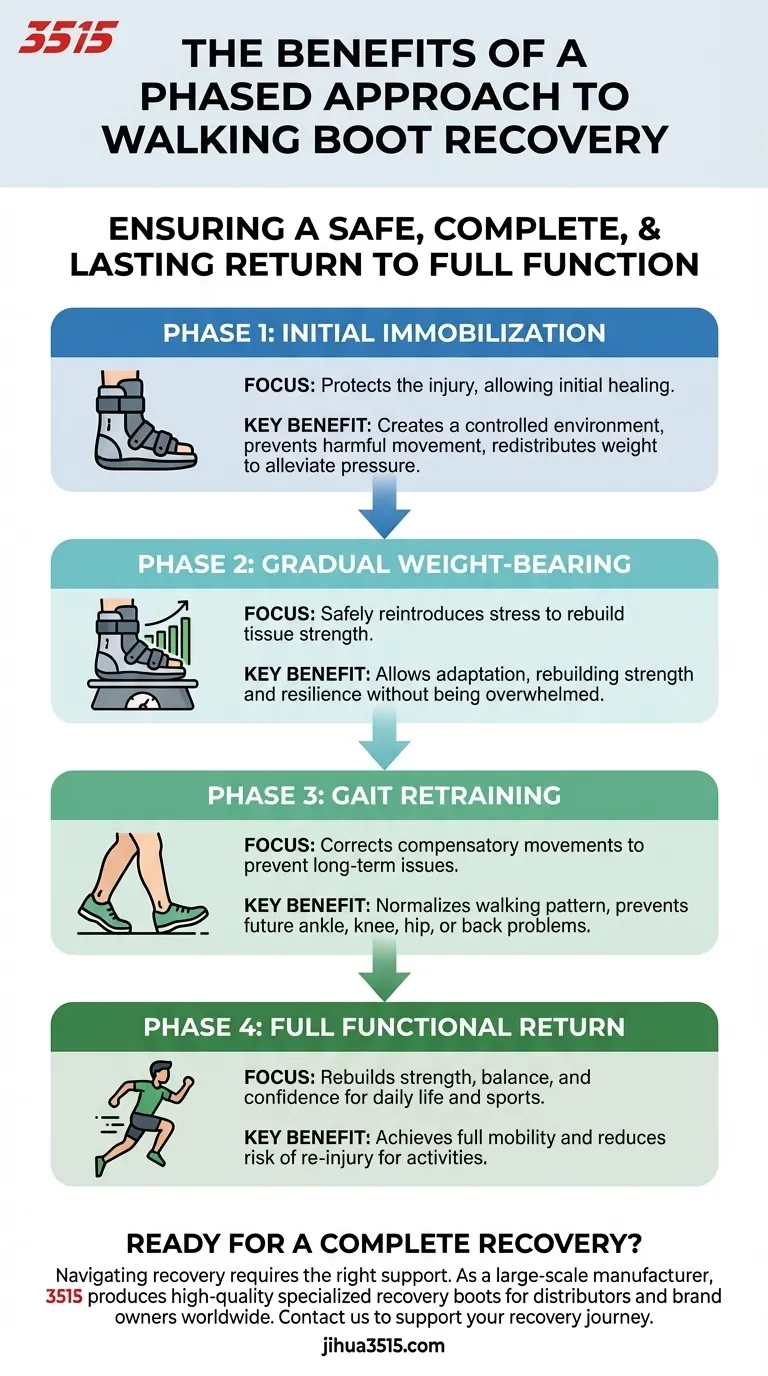In short, the primary benefit of a phased approach to walking boot recovery is that it ensures a safe, complete, and lasting return to full function. It transforms recovery from a simple waiting game into a structured process that rebuilds your body’s capability and minimizes the risk of re-injury.
The core principle is that true recovery isn't just about the initial healing of bone or tissue. It's about systematically and safely re-acclimating the injured area to the stresses of daily movement, which is a goal a phased approach is specifically designed to achieve.

The Purpose of a Phased Recovery
A walking boot is an essential tool, but it's only the first step. The structured plan you follow while using and eventually removing it is what determines the quality of your long-term outcome.
More Than Just Waiting for Healing
An injury doesn't just damage tissue; it disrupts your body's entire functional chain, affecting muscle strength, balance, and movement patterns.
A phased approach addresses all of these elements in sequence, ensuring no component of your recovery is left behind.
The Boot's Critical Role
The walking boot initiates the recovery by creating a controlled environment for healing. Its rigid structure immobilizes the injured area to prevent harmful movement.
It also redistributes your body weight across the foot, alleviating direct pressure on the healing bones, tendons, or ligaments. This allows you to begin moving with less pain much sooner.
A Gradual Reintroduction to Stress
The central idea of a phased recovery is progressive loading. You start with maximum protection and gradually reintroduce stress as the tissue heals and strengthens.
This deliberate process allows your body to adapt safely, rebuilding strength and resilience without being overwhelmed, which is the fastest way to a durable recovery.
The Risks of Rushing the Process
Deviating from a structured plan by trying to speed things up is one of the most common recovery mistakes. It often leads to significant setbacks.
The Danger of Re-Injury
The most immediate risk is re-injury. Tissue that feels "okay" may not yet have the tensile strength to handle the full, unsupported force of walking or twisting.
Moving out of the boot too soon can easily damage the delicate, healing structures, effectively resetting your recovery timeline.
Developing Poor Movement Habits
While in a boot, your body naturally develops a compensatory walking pattern. If you transition out of the boot too quickly, this altered gait can become ingrained.
A proper final phase focuses on actively normalizing your walking pattern to prevent long-term issues in your ankles, knees, hips, or back caused by these bad habits.
Achieving Only Partial Recovery
Without a focus on rebuilding function, you might stop when the pain stops. However, this often leaves you with residual weakness, stiffness, or poor balance.
This incomplete recovery makes you far more susceptible to future injuries and may prevent you from returning to previous activities like running or sports.
Making the Right Choice for Your Recovery
Successfully navigating your recovery is an active process. The goal is to move from a state of protection to a state of full, confident function.
Follow Professional Guidance
Your phased plan should be guided by your doctor or physical therapist. They determine the timeline for progressing from one phase to the next based on your specific injury and healing progress.
Lean on Your Support System
Recovery can be mentally and emotionally taxing. Relying on family, friends, or support groups provides encouragement and practical help with daily tasks.
This emotional comfort is a critical and often overlooked component of a manageable and successful recovery journey.
How to Apply This to Your Goal
Your mindset toward the phased plan should align with your ultimate objective.
- If your primary focus is preventing re-injury: Treat each phase as a mandatory checkpoint, ensuring you have mastered it before your doctor clears you for the next one.
- If your primary focus is returning to sports or high-impact activity: Pay extra attention to the final phase, which focuses on rebuilding strength, flexibility, and balance beyond simple walking.
- If your primary focus is simply walking comfortably again: Diligently follow the transition plan to normalize your gait and eliminate any limp or compensation.
By embracing a structured, phased approach, you are taking direct control of your long-term health and mobility.
Summary Table:
| Phase Focus | Key Benefit |
|---|---|
| Initial Immobilization | Protects the injury, allowing initial healing. |
| Gradual Weight-Bearing | Safely reintroduces stress to rebuild tissue strength. |
| Gait Retraining | Corrects compensatory movements to prevent long-term issues. |
| Full Functional Return | Rebuilds strength, balance, and confidence for daily life and sports. |
Ready to ensure a complete and lasting recovery?
Navigating a walking boot recovery requires the right support. As a large-scale manufacturer, 3515 produces a comprehensive range of high-quality footwear, including specialized recovery boots designed for durability and comfort. Our products are trusted by distributors, brand owners, and bulk clients worldwide.
Let us help you or your clients step confidently towards full mobility. Contact our experts today to discuss your footwear needs and discover how 3515 can support your recovery journey.
Visual Guide

Related Products
- Safety Footwear Wholesale Manufacturer for Custom OEM/ODM Production
- Wholesale Customizable Safety Boots Durable & Protective Footwear Manufacturing
- Premium Grain Leather Safety Boots for Bulk Supply
- Wholesale Safety Footwear Manufacturer for Bulk & Custom OEM Orders
- Premium Wholesale Wheat Nubuck Safety Boot with Rapid Lacing System
People Also Ask
- Is it normal to wear shoes in the house? A Guide to Hygiene, Comfort & Culture
- What do heavy duty boots do? Protect Your Feet in Demanding Work Environments
- What cultural and environmental considerations are tied to wearing shoes indoors? Balance Hygiene, Tradition, and Foot Health
- What are OSHA approved shoes? Understanding the Correct Standards for Workplace Safety
- How long can you wear safety boots? The Lifespan is Determined by Wear, Not Time



















